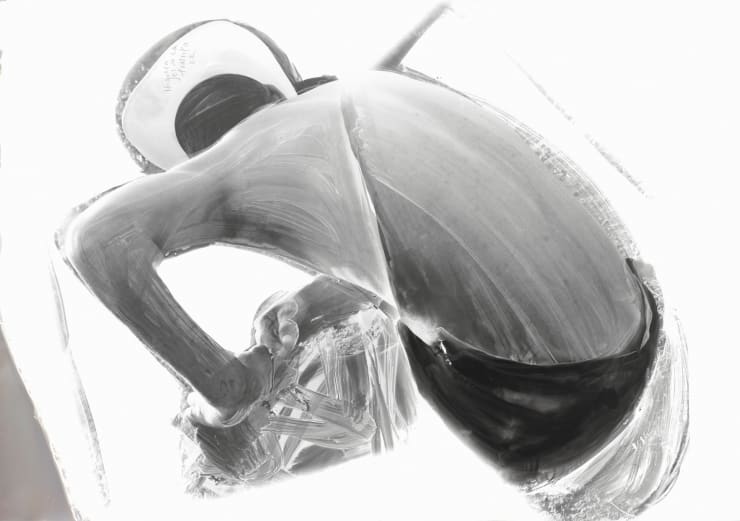Gerald Incandela: New Photographic Drawings
Edward Cella Art & Architecture announces the gallery’s first exhibition of 2010, Gerald Incandela: New Photographic Drawings. To take place during Los Angles Art Month, the exhibition is artist’s first solo exhibition in Los Angeles of his monumental, hand- brushed composite photographs that represent a technical and aesthetic tour de force. Incandela’s innovative photographic works were last exhibited in Los Angeles in 1998 as part of the Getty Museum’s groundbreaking debut exhibition.
Incandela emerged as a photographer and filmmaker in the mid-1970s, at a time of profound and restless investigation of photography and its processes. Incandela is recognized for his unique photographic process which incorporates composite negatives and the selective appliction of developer and fixer by hand, in a drawing like gesture, that transformed the monocular vision of the camera into a painterly medium. In the words of critic Klaus Kertess, “Incandela subverted photography with its own tools and brought focus to the dialogue between the eye of the artist, the eye of the camera, and the eye of the viewer.”
Edward Cella Art & Architecture announces the gallery’s first exhibition of 2010, Gerald Incandela: New Photographic Drawings. To take place during Los Angles Art Month, the exhibition is artist’s first solo exhibition in Los Angeles of his monumental, hand- brushed composite photographs that represent a technical and aesthetic tour de force. Incandela’s innovative photographic works were last exhibited in Los Angeles in 1998 as part of the Getty Museum’s groundbreaking debut exhibition.
Incandela emerged as a photographer and filmmaker in the mid-1970s, at a time of profound and restless investigation of photography and its processes. Incandela is recognized for his unique photographic process which incorporates composite negatives and the selective appliction of developer and fixer by hand, in a drawing like gesture, that transformed the monocular vision of the camera into a painterly medium. In the words of critic Klaus Kertess, “Incandela subverted photography with its own tools and brought focus to the dialogue between the eye of the artist, the eye of the camera, and the eye of the viewer.”
In the darkroom, Incandela manipulates the images captured with the lens of his camera by creating new compositions though the combination of multiple negatives in a panorama like effect. During the course of developing the large format, black and white prints, Incandela selectively applies developer and fixer on paper with a brush as to reveal and animate selected elements of the captured image. This process also allows for him to create both warm and cool tones on the same unique, master print. Transforming the chemistry of photography into a charcoal or ink-like media and using a drawing-like process, Incandela employs his own bold, meaningful gestures to portray and retrace his subjects conveying his intuitive understanding and visual exploration of them.
The exhibition presents Incandela’s newest series of works, which employs the nude male figure to explore the artist’s ongoing concern with pictorial space. Exploiting the angularity of the male body, the artist make use of a bent arm or leg as a gateway or entry point into the spatial depth that the camera has recorded. Using his distinct, drawing like process, Incandela makes marks that appear to be placed on different illusionary planes of the print, the ultimate effect of which is to expand the image’s perception of depth. This achievement is heightened though compositing multiple source images, each with there own point of perspective. For the artist, “the challenge was to express more sensuality in the materials and their application than in the image of the nude body. The pictorial action is in the negative spaces surrounding the figure.”
Since 1975, Incandela has been concerned with bridging the mediums of photography and drawing. His early explorations attracted the interest of noted collector, Sam Wagstaff who acquired more than thirty works that are now held at the J. Paul Getty Museum. Both the Museum of Modern Art and the Metropolitan Museum of Art in New York also hold examples of the artist’s work.
-
 Gerald Incandela, Going Through, #3, 2009
Gerald Incandela, Going Through, #3, 2009 -
 Gerald Incandela, Going Through, #1, 2009
Gerald Incandela, Going Through, #1, 2009 -
 Gerald Incandela, Going Through, #2, 2009
Gerald Incandela, Going Through, #2, 2009 -
 Gerald Incandela, Leaning, 2009
Gerald Incandela, Leaning, 2009 -
 Gerald Incandela, The Bench, 2009
Gerald Incandela, The Bench, 2009 -
 Gerald Incandela, Open, #1, 2009
Gerald Incandela, Open, #1, 2009 -
 Gerald Incandela, Stretch, 2009
Gerald Incandela, Stretch, 2009 -
 Gerald Incandela, Open, #2, 2009
Gerald Incandela, Open, #2, 2009 -
 Gerald Incandela, Sitting, 2009
Gerald Incandela, Sitting, 2009 -
 Gerald Incandela, Going Through, #4, 2009
Gerald Incandela, Going Through, #4, 2009










